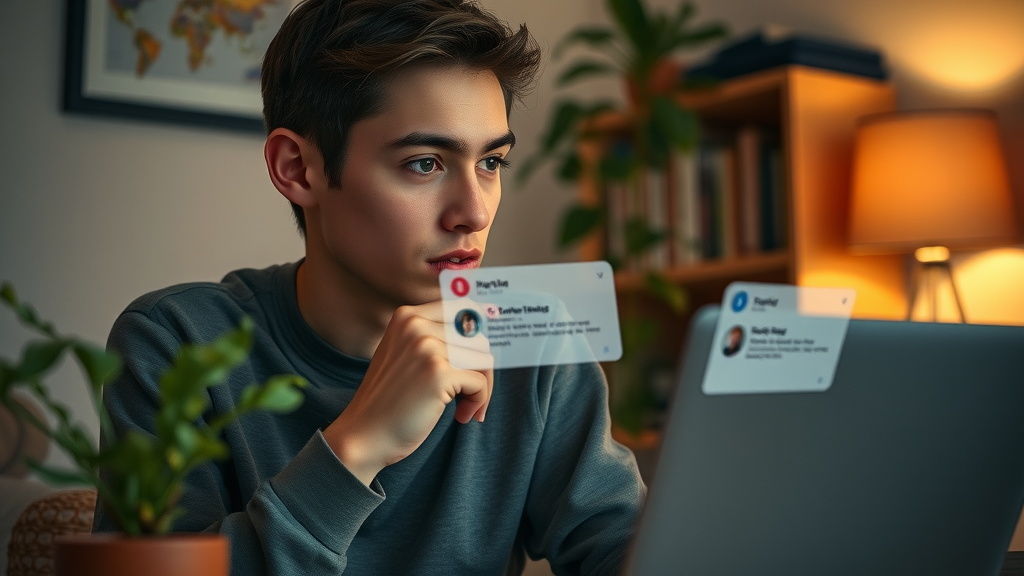Are social media platforms quietly sabotaging your daily focus? If you’ve ever found yourself lost in endless scrolling or distracted by blinking notifications, you’re not alone. This in-depth guide uncovers how your favorite social networks impact your workday and shares science-backed solutions to put you back in the productivity driver’s seat.

How Social Media Platforms Affect Daily Productivity
The integration of social media platforms into our everyday routines has become second nature. Yet, these seemingly innocent tools can carry a heavy cost—your productivity. Notifications, messages, and content feeds are meticulously engineered to keep your attention, often pulling you away from important tasks. For example, you might begin your morning checking messages on Facebook or Instagram and suddenly realize thirty minutes have slipped away.
The effect compounds throughout the day: each quick glance disrupts your focus, and those tiny interruptions quickly add up. Typical scenarios include replying to a friend’s DM during meetings or browsing Twitter for “just a minute” that turns into fifteen. This constant digital tug-of-war shapes the quality of your work, blurring the boundary between focused effort and fragmented attention.
Whether you’re a student, professional, or entrepreneur, recognizing the reach of social media is essential. Understanding how these platforms shape your workflow is the first and most important step in reclaiming your productivity and using social media platforms as a tool to your advantage—rather than a hurdle to overcome.
The Instant Gratification Loop of Social Media Platforms
Most social media platforms operate on an instant gratification model, designed to trigger multiple dopamine releases for every like, comment, or notification. This constant drip of rewards can quickly train your brain to crave frequent interaction, creating a cycle that is hard to break. These quick hits of approval reinforce the habit of reaching for your phone, even in the middle of important projects, meetings, or study sessions.
Over time, this loop chips away at your ability to focus on long-term goals or sustained tasks. Since each notification promises a brief moment of pleasure, you’re conditioned to prioritize checking in over challenging work. The result? Productivity slips as your attention span dwindles and distractions become normalized.
Breaking this pattern requires mindful awareness of how social media platforms manipulate your reward system. Recognizing the psychological hooks embedded in your daily scroll can empower you to make intentional choices about when and how you engage online.
Social Media Platforms vs. Focus: Understanding Cognitive Distraction
When you succumb to the lure of social media platforms during your workday, you do more than just lose time—you fragment your cognitive resources. Each interruption, whether it’s a message or a trending meme, derails your train of thought and makes it harder for your brain to return to productive tasks. This state of “continuous partial attention” hampers deep work, making it tough to complete complex projects without errors or frustration.
Research shows that after checking a phone notification, it can take up to 23 minutes to regain your original focus. In jobs that demand critical thinking or creative problem-solving, these constant breaks diminish the quality of your output, force you to multitask ineffectively, and can even increase stress or mental fatigue.
To combat this, consider silencing notifications or blocking access during peak focus hours. Setting boundaries allows your brain to settle into a productive rhythm—and reduces the risk that social media platforms will hijack your workday.

Measuring the Impact: Productivity Loss Attributable to Social Media Platforms
Quantifying the true toll of social media platforms on productivity gives concrete insight into how these tools shape modern work life. Surveys reveal that employees may spend up to two hours a day on non-work-related social sites—adding up to over ten hours per week. This is time that could otherwise be invested in completing key tasks, professional development, or even taking real breaks that aid focus.
The cost isn’t just measured in hours; frequent distractions decrease engagement, dampen creativity, and lengthen project timelines. In team settings, the ripple effect can delay group objectives or force others to pick up the slack. Evaluating personal usage patterns is the first step in understanding why even the most well-intentioned users can lose significant productivity—and how setting boundaries can reverse this trend.
Consider tracking your daily app usage for a week and compare that to goal-setting or project timelines. The results are often eye-opening, reinforcing the importance of mindful interaction with social media platforms if you hope to reclaim lost time.
| Activity | Average Daily Time | Weekly Total |
|---|---|---|
| Checking Social Media Platforms | 2 hours | 14 hours |
| Email Management | 1 hour | 7 hours |
| Focus Work (Writing, Analysis, Creation) | 4 hours | 20 hours |
| Professional Development (Courses, Training) | 30 minutes | 3.5 hours |
| Breaks & Non-digital Relaxation | 1 hour | 7 hours |
Survey Data: How Employees Use Social Media Platforms at Work
National productivity studies consistently indicate that a significant portion of employees use social media platforms during working hours, often beyond legitimate work purposes. Recent surveys found that more than 70% of employees admit to checking sites like Facebook, Instagram, or LinkedIn at their desks, even without a work-related reason. These surveys highlight that social media is not just a personal distraction, but an embedded part of corporate culture.
Employees cite reasons ranging from “taking a mental break” to “networking for future career opportunities.” While these justifications vary, the reality is that such activities can fracture concentration, especially if unchecked. Employers may underestimate the cumulative effect—multiple five-minute checks across a team translates into lost hours each week, affecting deadlines and collaborative projects.
This data should prompt both individuals and organizations to consider official guidelines and digital well-being strategies, ensuring social media use remains purposeful and does not erode team performance or morale.

Identifying the Signs: Are Social Media Platforms Disrupting Your Workflow?
The subtle encroachment of social media platforms on your day can be hard to recognize until productivity drops or deadlines slip. Common indicators include trouble completing tasks on time, frequent task-switching without results, and a mounting to-do list that never seems to shrink. Other signs are increased stress, procrastination before starting key tasks, and difficulty remembering instructions or meeting objectives.
Recognizing these red flags is the key to making positive change. Self-awareness prevents digital distractions from derailing your biggest goals. Once you acknowledge these signs, you can implement strategies to tame your interaction with social media platforms and regain control over your day.
If any of these situations sound familiar, it might be time for a productivity audit—and to address the underlying habits fueling inefficient work cycles.
- Inability to focus for more than 20 minutes without checking your phone or social feeds
- Frequent feelings of stress or overwhelm as tasks pile up
- Procrastination due to constant incoming messages or notifications
- Trouble remembering what you were working on after picking up your phone
- Feeling busier but accomplishing less each day
Common Excuses for Excessive Social Media Platform Usage
It’s easy to rationalize frequent visits to social media platforms with a set of well-worn excuses. “I’m just catching up with friends,” “It relaxes me,” or “It’s part of my job” are common refrains that downplay the cumulative impact these habits have on productivity. Some people tell themselves that a quick scroll provides inspiration or sparks creativity, but in most cases, it only leads to further distraction.
Another popular excuse is the fear of missing out (FOMO), which pushes individuals to check for the latest trends or news. Others cite networking and work responsibilities, especially in roles that actually do require monitoring social platforms. The reality is, abusing this justification often blurs the line between necessary engagement and mindless scrolling.
Being honest about the reasons behind your usage patterns is the first step to drawing boundaries and reaping the true benefits of social media platforms .
Mastering Social Media Platforms for Positive Productivity
Transforming your relationship with social media platforms into a positive force isn’t just possible—it’s essential for modern professionals. With mindful strategies, you can still reap the networking, learning, and outreach benefits of platforms without succumbing to their pitfalls. Establishing digital discipline allows you to remain connected while keeping productivity as your north star.
Setting app limits, creating tech-free blocks in your calendar, and switching work-related social channels to desktop (instead of mobile) are practical adjustments. Over time, these boundaries wire new habits that help you use social media as a tool for learning, collaboration, and brand building, rather than letting it control your workflow.
Remember: you’re not aiming for “cold turkey” abstinence—just a sustainable, focused strategy that delivers on the advantages of social media while minimizing productivity costs.
- Set designated “social times” —schedule specific windows to check and reply, so platforms don’t leak into your focus hours.
- Use app blockers or screen time features —these limit access and provide gentle nudges if you exceed your preset boundaries.
- Turn off non-essential notifications —remove the temptation of constant pings so you control when you check-in, not the algorithm.
- Move apps off your home screen —this small change adds a moment of pause, blocking impulsive clicks.
- Prioritize in-person or direct communications —whenever possible, use email, calls, or meetings for work discussions instead of DMs.

Scheduling and Boundaries: Taking Back Control Over Social Media Platforms
Winning the productivity battle with social media platforms hinges on proactive scheduling and firm boundaries. Start by identifying your most productive hours of the day—often mornings for most people—and designate them as “no social” zones. Communicate these boundaries to colleagues or housemates to foster accountability and decrease interruptions.
Invest in calendar tools or digital wellbeing apps that block access to distracting platforms during work sprints, freeing up mental space for deep focus. For roles that require social media management, set clear time blocks for research, posting, and engagement—then log out. This disciplined approach minimizes context-switching, sharpens output, and helps you experience the full benefit of downtime when “social time” arrives.
"Social media platforms can build or break your productivity—mastering them means mastering your workflow."
Benefits: Using Social Media Platforms to Enhance Productivity
While it’s easy to point to the pitfalls, social media platforms can genuinely fuel your growth, knowledge, and career if used intentionally. From joining industry groups to accessing real-time learning, these platforms provide instant connections to mentors, peers, and clients worldwide. When approached thoughtfully, social channels become launchpads for innovation—not just roadblocks to productivity.
LinkedIn can propel professional networking, while Twitter and specialized Facebook groups serve as vibrant hubs for digital learning. By curating who and what you follow, you can ensure your feeds deliver timely updates, industry insights, and resources rather than rabbit holes.
Harnessing these benefits requires you to use social media not as a default distraction, but as a targeted supplement to your career or studies.
- Connect with professionals in your field, expanding your network globally
- Access cutting-edge industry news and expert insights the moment they are published
- Participate in online courses, webinars, and workshops promoted on social media
- Join expert groups or forums focused on your career interests
- Get feedback on projects from a broader and more diverse audience
Turning Social Media Platforms Into Learning Tools
One of the lesser-known advantages of social media platforms lies in their potential as learning hubs. Thousands of professionals now use sites like LinkedIn Learning, YouTube, and Twitter threads to deepen their expertise and discover new topics. Want to learn a tech skill or get insider advice on industry shifts? There’s likely a community or expert sharing daily tips for free.
The key is to shape your algorithm. Follow industry voices, subscribe to digital learning channels, and mute or unfollow time-wasting sources. This approach turns your feed into a daily source of professional motivation, ideas, and resources that inspire innovation rather than waste precious hours.
Ultimately, when you approach social media intentionally, these platforms can supplement your formal education—helping you stay adaptable and knowledgeable in a rapidly changing world.

People Also Ask: Do Social Media Platforms Always Hurt Productivity?
It’s a common misconception that social media platforms are inherently negative for productivity. In reality, their impact depends on the user’s intentions and boundaries. With self-management, these platforms can be transformed into catalysts for collaborative work, networking, and rapid information sharing—especially when used within a clear framework.
While potential distractions exist, choosing the right tools and strategies allows you to benefit from real-time updates, task management integration, and instant professional feedback that can actually enhance your workflow.
The difference is in the approach: Is social media your servant, or your master?
Can Social Media Platforms Be Used for Efficient Work Communication?
Absolutely. Many teams leverage workplace-tailored versions of social media platforms —like Slack, Microsoft Teams, and LinkedIn Groups—for collaboration, group projects, and sharing updates. Used intentionally, these platforms break down communication silos, foster quick feedback, and streamline project management, boosting team productivity.
It’s important, however, to separate work channels from personal feeds. Establish clear expectations for how and when to use social media for business communication, so lines don’t blur and distractions are minimized. Consider designated chat hours or “reply by” guidelines to balance responsiveness with uninterrupted work focus.
When approached strategically, work-based social networks can truly elevate productivity, innovation, and team morale.
What Tools Help Manage Social Media Platform Usage?
A wealth of digital tools exist to help you regain command over your time spent on social media platforms . Apps such as Freedom, FocusMe, and RescueTime allow users to block distracting sites for set periods, while tracking overall digital usage. Smartphone platforms like iOS Screen Time and Android’s Digital Wellbeing dashboard provide easy controls for app usage limits and reminders.
Browser plugins like StayFocusd or LeechBlock offer granular control for desktop users, enabling custom-block lists and scheduled access. Many productivity-minded individuals find combining these tools with analog tricks—such as a visible timer or a written “social media contract”—keeps habits in check even during high-stress periods.
Experiment with these options to discover the perfect combination that aligns with your workflow, responsibilities, and focus needs.
Frequently Asked Questions about Social Media Platforms and Productivity
- How do I set boundaries with social media platforms? Setting boundaries starts with defining daily “no social media” windows—like during work, study, or family time. Use app timers, notifications blockers, and communicate your plans with friends, coworkers, or household members so they respect your focused hours. Consistency builds stronger habits.
- Are there apps to help limit time on social media platforms? Yes! Tools like Freedom, FocusMe, StayFocusd, and built-in features like Apple’s Screen Time and Digital Wellbeing for Android give you the power to monitor and limit your usage. Experiment to find the tool that matches your workflow and adjust as necessary to avoid digital burnout.
- What are the most distracting features of social media platforms? The biggest productivity traps are real-time notifications, infinite-scrolling feeds, autoplay videos, and constant algorithm-driven content suggestions. Disabling notifications, unfollowing non-essential accounts, and setting clear engagement limits are crucial first steps in reducing these distractions.

Recap: Maximizing Productivity While Navigating Social Media Platforms
"Success on social media platforms starts with intentionality—let purpose, not habit, drive your online actions."
Evaluate your habits, apply mindful boundaries, and reimagine social media platforms as allies in your quest for growth. Consistently integrating productivity tools, strategic scheduling, and purposeful networking will ensure you maximize the benefits of social media without sacrificing your best work.
Ready to Conquer Social Media Platforms? Get Your Custom Game Plan
Want a social media plan built specifically for your business? Drop SOCIAL below or message us to get your custom game plan.
 Add Row
Add Row  Add
Add 




Write A Comment